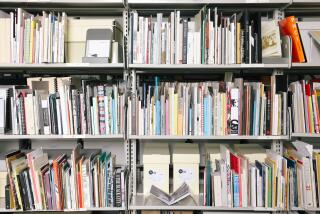Archives Hear America Singing : Trends: Indians hoping to recall their languages and fans who want to thank Hoagy Carmichael for the memories go to the same archives.
- Share via
BLOOMINGTON, Ind. — The melodic strains of a Hoagy Carmichael tune and the rhythmic chants of a near-forgotten Indian tribe mix surprisingly well at Indiana University.
Workers at the Archives of Traditional Music say their collection of sound--with some recordings nearly a century old--is probably the largest of its kind in the United States, outside the Library of Congress.
The facility focuses on ethnographic sound, recordings made at the site of an event rather than at a studio.
Songs, chants and prayers from an array of American Indian tribes dating to the 1890s make up the body of recordings.
There are also thousands of recordings of vocal and instrumental music--including American jazz and blues, and African and Latin music--folk tales, interviews, oral histories and manuscripts.
“Sound has an incredible power to move people,” said Ruth Stone, archives director. “It offers us an opportunity to go back and relive aspects of events that took place a long time ago.
“And sound is a dynamic thing. With a recording we can repeat certain aspects of events and imagine other aspects.”
Many older recordings are contained on fragile wax cylinders or wire spool devices, the forerunners of disc records and recording tape.
The facility contains more than 200,000 hours of recordings, Stone said. They’re contained on 7,000 wax cylinders, 250 wire spools, 3,700 cassettes, 70,000 record discs, 35,000 tape reels and 150 video tapes.
Carmichael, a native Hoosier and one of the century’s most prominent American songwriters, commands special attention.
The archives’ Hoagy Carmichael Room, dedicated to the memory of the Indiana University graduate who wrote such hits as “Lazy River,” “Thanks for the Memory” and “In the Cool Cool Cool of the Evening,” contains memorabilia donated by his family.
Security for the room--a sturdy door and lock topped off with a burglar alarm--is surprisingly rigid because of the penchant of devoted fans to carry off possessions of the composer, who died in 1981 at age 82.
“I was quite surprised to see that there were so many fans,” archive coordinator Marilyn Graf said during a tour of the Morrison Hall facility. “We’ve got little old ladies coming from Canada just to see this.”
The comfortable 1930s-style sitting room contains Carmichael’s piano, a mahogany jukebox, scripts, records, photos and other personal items.
A dining chair has parts of musical bars of “Stardust,” perhaps Carmichael’s most famous song, embroidered in its upholstery. The stitching was done by Carmichael’s mother, Graf said.
Recordings of Carmichael’s music are housed along with other archive holdings in a climate-controlled storeroom just outside the Carmichael Room.
Stone said the department’s main task is to preserve, catalogue, store and research such audio rarities.
Musicians, scholars, researchers, students, the public and other educational institutions use the archives. Indian tribes seeking insight into their heritage are frequent clients.
“We’re getting a lot of requests for Indian languages that are just about extinct. Some tribes are trying to reclaim their languages,” Graf said.
The Wavapai Indians of Arizona made one such request, and Graf said she so far has uncovered about 20 hours of recordings made by the tribe’s ancestors.
The archives’ oldest recording was made in 1893 and contains the songs and chants of the Kwakiutl Indians of British Columbia. The recording is contained on a wax cylinder, and its sound is rough but easily distinguishable.
This library of sound also includes an array of Navajo songs and stories from the 1890s, music and tales from a 1901 expedition to Siberia and an audio record of an anthropologist’s turn-of-the-century journey to China.
Thomas Edison invented the phonograph recorder in 1877, but the archivists said it was more than a decade before scholars and scientists adapted the device to capture ethnic sounds.
According to Stone, people then began bringing back recordings of their travels just as they now bring back photographs. The collection grew as the travelers exchanged their original recordings for high-quality working copies, the archivists explained.
The archives are open to students and the public through a special listening library.
“We want the sounds here to have some life other than just storing them in a vault,” Stone said.
More to Read
The biggest entertainment stories
Get our big stories about Hollywood, film, television, music, arts, culture and more right in your inbox as soon as they publish.
You may occasionally receive promotional content from the Los Angeles Times.










